What is Greek and Roman Fashion?
Introduction
When you think of Ancient Roman and Greek Fashion you may think of the classics like the tunic, the stola, or the toga, but you maybe not have heard of other pieces such as, the chiton or the peplos. I will be explaining what those are but first I will start by explaining the basic clothing.
Tunic
The tunic is a classic example of Roman and Greek clothing. It was made of two rectangles that were sewn together on the sides but there was just enough room left to put your arms through. It was then fastened at the top with a safety pin like thing called a Fibula. The tunic was not fancy as it was worn everyday, casually.
Stola
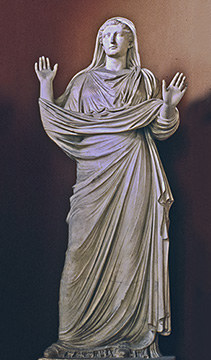
After a woman got married she would wear a stola show she was married. It was a long, sleveless dress that was worn over the tunic. The stole was usually made out if wool.
Toga
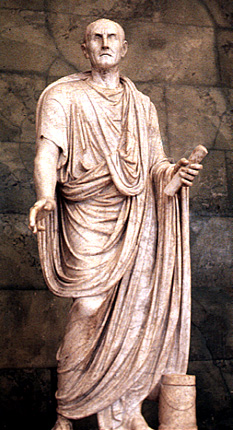
The toga was like the male version of stola. It was a semi-circular piece of white wool fabric that was wrapped around. Like the stola, it was also worn over the tunic.
Peplos

You may have heard of the word peplum. The word peplum comes from the word peplos. The peplos is a type of Greek dress that as shown in the picture is a rectangular piece of fabric that is folded to create a little flap as seen in the picture above.
Chiton
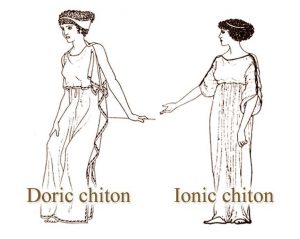
You are probably wondering how to pronounce this word. It is pronounced kite-on. If you click on kite-on it will take you to YouTube where you can listen how to pronounce chiton. The chiton is a a Greek dress. There are two different types, the Doric and the ionic. The Doric chiton is sleeveless while the ionic has sleeves.
My Product
For my product I decided to make an Ancient Roman and Greek Fashion magazine.
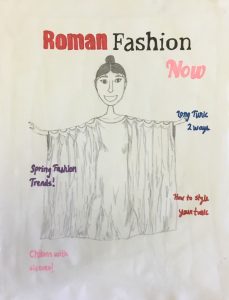
Here is a picture of the cover. The name of this magazine is Roman Fashion Now.

This is an advertisement for Cassidy and Katey’s project.


This is DIY instructions for making your own chiton with sleeves dress.

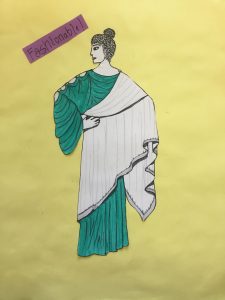
People normally think the only colors the Romans used were white and red, but they used more than just those colors. They used white, blue, purple, red, brown, green, and black.

This is an advertisement for Josiphine’s project.

This is an advertisement for Andy’s project.
Works Cited
“Dressing to Impress in Greece and Rome.” Arts and Humanities Through the Eras, edited by Edward I. Bleiberg, et al., vol. 2: Ancient Greece and Rome 1200 B.C.E.-476 C.E. Gale, 2005, pp. 102-106. Gale Virtual Reference Library, http://link.galegroup.com/apps/doc/CX3427400231/GVRL?u=sant89825&sid=GVRL&xid=0893aa51. Accessed 21 May 2018.
McManus, Barbara F. “Roman Clothing, Part II.” Roman Social Class and Public Display, Aug. 2003, www.vroma.org/~bmcmanus/clothing2.html.
McManus, Barbara F. “Roman Clothing, Part I.” Roman Social Class and Public Display, Aug. 2003, www.vroma.org/~bmcmanus/clothing.html.
Severy, Merle, and Emily Vermeule. Greece and Rome: Builders of Our World. Washington, National Geographic Society, 1977.
Tierney, Tom. Greek and Roman Fashions. Dover Publications, 2001
